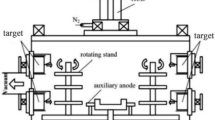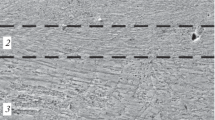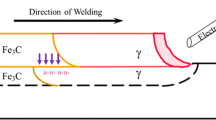The mechanical properties possessed by surface layers of metal alloys hardened by severe plastic deformation methods were studied by indentation. The test materials were AISI O2 and AISI 316L steels and D16 aluminum alloy. Most scientific papers evaluate the mechanical properties of hardened surface layers and thin coatings only by hardness measurement. Hardness alone cannot characterize the ductility of a material without using modern concepts for determining the physical ductility from hardness. The mechanical behavior of a material can only be characterized by determining both the ductility and the yield stress. These quantities can be found by micro- or nanoindentation. We developed indentation methods to find the physical ductility δH and yield stress σSH of the surface layers of metal alloys hardened by various techniques (with analysis of changes in these characteristics across the hardened layer) to select the optimal hardening method. The hardening characterized by the ratio between the yield stresses of the hardened layer and the starting material \( \left({\upsigma}_{{\mathrm{SH}}_{\mathrm{hard}}}/{\upsigma}_{{\mathrm{SH}}_{\mathrm{start}}}\right) \) was much greater for all studied alloys than the hardening characterized by the hardness ratio (HVhard/HVstart). Thus, the use of δH and σSH obtained from standard microhardness measurements enhanced the informative nature and efficiency of the indentation method in studying the mechanical behavior of metal alloy layers hardened by various techniques.
Similar content being viewed by others
Avoid common mistakes on your manuscript.
INTRODUCTION
The mechanical properties possessed by the surface layers of most metallic parts determine their service properties. In this regard, surface engineering is advancing rapidly and provides for the development of methods to harden and protect the surfaces against environmental effects through their hardening and applying thin coatings.
To study the mechanical properties of hardened layers is an important task that cannot be accomplished without involving current advances in indentation physics.
Unfortunately, the vast majority of scientific papers evaluates the mechanical properties of hardened surface layers and thin coatings only from hardness measurements, inadequately characterizing these properties. Most papers do not assess the ductility at all because the elongation at break δ cannot be determined in tensile tests for hardened layers and thin coatings.
The indentation techniques developed [1,2,3] allowed the physical ductility δH [2] and yield stress σSH of bulk materials with different crystalline structures and atomic bonds to be assessed [3]. The effectiveness of using the physical ductility δH and yield stress σSH found by indentation is shown in [4]. The paper established that the wear rate W in friction in hardened steel surface layers was described by a simple relationship: W = NδH/σSH (at N = = const).
The objective of this research effort is to ascertain whether the yield stress σSH and ductility δH (determined by indentation) can be used to evaluate the mechanical properties possessed by the surface layers of metallic alloys hardened in different ways. The research results are intended to choose the optimal hardening method.
There are numerous papers focusing on the hardening of surface layers on steels and other metallic alloys. Hardened layers on the surface of parts substantially improve their service properties. There is a number of severe plastic deformation (SPD) methods that effectively influence the mechanical properties of surface layers: ultrasonic shock treatment (USST), shot blasting (SB), tribological treatment, and treatment with vibrating balls and abrasive particles [5,6,7,8].
Hence, USST is an effective method for hardening aluminum-based [5] and titanium-based [6] aviation alloys. These papers proved that USST promoted high plastic strain localized in thin surface layers, while the thickness of modified surface layers and the mechanical properties of materials turned out to be much greater than after conventional (mechanical, thermochemical, electrical, and other) treatment.
A complex method combining thermal laser treatment (LT) and USST is very promising for the surface hardening of steels. This method was developed and tested in [9, 10] to find that complex treatment substantially increased the hardness, strength, and wear resistance of the surface layers of AISI 1045 and AISI D2 steels. These papers also studied the physical nature of hardening resulting from additional grain/subgrain refinement, increased dislocation density, and structural and substructural stability ensured by nanosized particles of the other phase. The hardness can be increased by 2.5 times (from 3100 to 7800 MPa) following USST alone. The SPD methods are peculiar in that they induce a structural gradient across the near-surface layer in nanosized, submicron, and micrometer grain size ranges and a dislocation density gradient, in turn leading to a layerwise change in the microhardness.
To analyze the mechanical properties of hardened layers on steels and aluminum-based alloys, we first used the method for determining the physical ductility δH [2, 11] and the method for calculating the yield stress σSH from hardness HV and physical ductility δH [1, 3]. Variation in the mechanical properties was studied versus the distance from the sample with a hardened surface layer. The yield stress σSH corresponds to the yield stress σS determined by mechanical compression tests at strain ε ≈ 7.6% involving Vickers hardness measurement.
EXPERIMENTAL PROCEDURE
The paper presents published data on the surface layers of AISI O2 [4] and AISI 316L [7] steels and D16 aluminum alloy [5] hardened by different methods (Table 1). The standard metallic alloys were chosen so as to compare the effectiveness of different surface treatment methods involving analysis of different modified layer thicknesses (70–300 μm).
Experimental data on variation in the modified layer hardness at different distances from the surface (microhardness was measured in cross-section of the samples at an indenter load of 1–2 N) were used.
The dependence of hardness on distance to the surface in hardened surface layers is established by measuring hardness on cross-sectional samples or samples made at an angle to the surface. The hardness H is difficult to measure on the surface itself, i.e., at h = 0 in H = f(h). In most cases, this dependence is shown without the hardness at h = 0 and the hardness values found by indentation of hardened surface layers are provided individually [8]. In addition, hardness on the surface is determined without making a metallographic section, which increases the measurement error and decreases accuracy.
The hardened layer can commonly acquire strain texture, leading to hardness anisotropy. The issue of hardness measurement at h = 0 is especially significant for thin coatings with a large hardness gradient. In this connection, using the results reported in [4], where the dependence HV = f(h) is provided for a thin hardened layer with a large hardness gradient found by LT + USST on AISI O2 steel, we calculated HV at h = 0 by computer extrapolation of the hardness values measured on a sample made at an angle to the surface.
The theory and methodology for determining the physical ductility (δH = plastic strain/total strain) from hardness measurement were developed in [2].
In case of indentation with a Vickers pyramid, the ductility characteristic is defined as
where ν is Poisson’s ratio and E is Young’s modulus.
The overview [11] demonstrates that δH should be determined in analyzing the effect of chemical composition, thermomechanical treatment, and structural state on the hardness and mechanical properties of the materials. The ductility characteristic δH is widely used by many researchers, including that in the development of thin coatings and surface layers [4, 12,13,14, 17,18,19]. There are clearly no other ways to determine ductility in this case. Nevertheless, the cited papers did not study layerwise change in δH from the sample surface as we did in our paper.
At present, the physical relation of hardness to yield stress σS [15] can be considered justified:
where HM is the Meyer hardness (average contact pressure) and C is the Tabor parameter. In particular, we have HM = 1.08HV for the Vickers indenter, considering that HV = HM · sinγ (taper angle γ = 68°).
To determine the parameter C and yield stress, we proposed the use of Johnson’s indentation model [15]. The model analyzes the dependence of C on the elastic modulus, yield stress, and indenter geometry. This model was improved in [3]. A system of three transcendental equations with three unknowns was obtained for this model to determine the yield stress. The calculated Tabor parameter C is in good agreement with C found from the ratio of hardness and yield stress determined in standard mechanical compression tests. Hence, the system of equations can be used for the accurate determination of yield stress from hardness.
The paper [3] ascertained the physical meaning of the parameter C and established the theoretical dependence δH(C), containing C in implicit form:
where \( \alpha =1-\frac{2\left(1-2\nu \right)}{3\left(1-\nu \right)} \), \( \lambda =\frac{1-\nu -2{\nu}^2}{1-\nu } \), and \( z=\mathrm{ctg}\gamma -\frac{2 HM\left(1-{\nu}_i\right)}{E_i} \)(νi is the indenter’s Poisson’s ratio and is the indenter’s Young’s modulus). Mathematical software allows the Tabor parameter C to be easily found with Eq. (3).
The correlation C(δH) was used to develop a simplified method to determine the Tabor parameter and yield stress σSH with standard indentation results. Figure 1 schematizes the theoretical dependence C(δH) (solid line) and experimental results (data points) for materials with different crystalline structures and atomic bonds. The method for determining C is intended to:
-
1.
Find the ductility by Eq. (1).
-
2.
Find the Tabor parameter C with the calibration curve (Fig. 1) or Eq. (3).
-
3.
Calculate σSH by equation σSH = HM/C.
Calibration curve for determining the Tabor parameter using the ductility characteristic [3]: 1, 2) sequence of determining C with the curve
The Tabor parameter C and σSH were defined in this simplified way for hardened surface layers of metallic alloys. The results are summarized in Table 1 and Fig. 2.
DISCUSSION OF RESULTS
Figure 2 illustrates a layerwise variation in the ratio between the hardness of the hardened layer and starting material, HVhard/HVstart, ratio between the yield stresses of the hardened layer and starting material, σSHhard/σSHstart, ductility characteristic δH, and Tabor parameter C. As is seen, besides variations in the yield stress (increasing toward the surface) and physical ductility δH (decreasing toward the surface) across the hardened layer, the Tabor parameter C changes as well, decreasing toward the surface, i.e., with increasing hardening. For all studied alloys, the yield stress ratio (σSHhard/σSHstart) increases much greater than the hardness ratio (HVhard/HVstart). This confirms that the surface layer hardening should be characterized by the yield stress σSH (corresponding to the yield stress σS determined in mechanical compression tests at total strain 7.6%) but not by hardness. Therefore, if strength of a material is assessed from hardness, the actual hardening is underestimated.
The overview [8] relates the surface layer hardening to the mechanisms whereby the nanostructured state forms across the modified surface layer. Depending on the composition of alloys following SPD, not only grain refinement occurs in the modified layer but also high stresses can be induced and structural transformation can proceed.
CONCLUSIONS
The microindentation method can be used to determine the yield stress (σSH) and physical ductility (δH) in studying the hardened surface layers. The use of δH and σSH found in standard microhardness measurements improves the informative nature and effectiveness of the indentation method in analyzing the mechanical behavior of metallic alloy layers hardened in different ways.
The published data on the mechanical properties of surface layers testify that the actual hardening of the surface layers of steels and metallic alloys should be characterized not only by increase in hardness but also in yield stress. The hardening of surface layers evaluated only from hardness is underestimated.
A simplified method for determining the yield stress, being equal to the yield stress σSH at strain ε ≈ 7.6%, that does not require complex calculations but provides adequate accuracy has been proved to be appropriate in practice.
References
Yu.V. Milman, S.I. Chugunova, and I.V. Goncharov, “Yield stress and ductility of materials determined by indentation,” in: V.V. Rubanik, Relevant Issues of Strength [in Russian], Vitebsk, Belarus (2018), Chapter 4, pp. 68–87.
Yu.V. Milman, B.A. Galanov, and S.I. Chugunova, “Plasticity characteristic obtained through hardness measurement (overview 107),” Acta Met. Mater., 41, No. 9, 2523–2531 (1993).
B.A. Galanov, Yu.V. Milman, S.I. Chugunova, I.V. Goncharova, and I.V. Voskoboinik, “Application of the improved inclusion core model of the indentation process for the determination of mechanical properties of materials,” Crystals, 87, No. 3, 1–13 (2017), https://doi.org/10.3390/cryst7030087.
Y.V. Milman, B.N. Mordyuk, K.E. Grinkevych, S.I. Chugunova, I.V. Goncharova, A.I. Lukyanov, and D.A. Lesyk, “New possibilities for characterization of wear rate of materials at friction by indentation,” Prog. Phys. Met., 21, 562–589 (2020), https://doi.org/10.15407/ufm.21.04.562.
G.I. Prokopenko, A.L. Berezina, S.M. Voloshko, I.E. Kotenko, and A.P. Burmak, “Surface densification of D16 alloy in ultrasound shock processing,” Metallofiz. Noveish. Technol., 32, No. 3, 397–403 (2010).
M.O. Vasiliev, V. S. Filatova, L. F. Yatsenko, and D. V. Kozyrev, “Microhardness of the VT6 alloy after ultrasound shock processing in different environments,” Metallofiz. Noveish. Tekhnol., 34, No. 6, 821–831 (2012).
A. Al-Janabi, M.R. Malayeri, and O.O. Bardan, “Performance of shot peened surfaces subject to crystallization fouling,” J. Therm. Sci., 111, 379–389 (2017).
S.I. Sidorenko, M.A. Vasiliev, and S.M. Voloshko, “Surface engineering: methods for metal surface hardening by severe plastic deformation,” in: L.M. Lobanov, I.V. Krivstun, and Yu.S. Borisov, Materials Science: Advances and Prospects: in 2 Vols., Vol. 1, Structural and Functional Materials [in Ukrainian], Akademperiodika, Kyiv (2018), pp. 393–413.
D.A. Lesyk, S. Martinez, B.N. Mordyuk, V.V. Dzhemelinskyi, A. Lamikiz, and G.I. Prokopenko, “Effects of laser heat treatment combined with ultrasonic impact treatment on the surface topography and hardness of carbon steel AISI 1045,” Opt. Laser Technol., 111, 424–438 (2019), https://doi.org/10.1016/j.optlastec.2018.09.030.
D. Lesyk, S. Martinez, B. Mordyuk, V. Dzhemelinskyi, and O. Danyleiko, “Effects of the combined laser-ultrasonic surface hardening induced microstructure and phase state on mechanical properties of AISI D2 tool steel,” in: V. Ivanov, J. Trojanowska, J. Machado, O. Liaposhchenko, J. Zajac, I. Pavlenko, M. Edl, and D. Perakovic, Advances in Design, Simulation and Manufacturing II, DSMIE 2019, LNME, Springer, Cham (2020), pp. 188–198, https://doi.org/10.1007/978-3-030-22365-6_19.
Yu.V. Milman, S.I. Chugunova, I.V. Goncharova, and A.A. Golubenko, “Plasticity of materials determined by the indentation method,” Prog. Phys. Met., 19, No. 3, 271–306 (2018), https://doi.org/10.15407/ufm.19.03.271.
A.V. Byakova, Yu.V. Milman, and A.A. Vlasov, “Application of the plasticity characteristic determined by the indentation technique for evaluation of mechanical properties of coatings: I. Specific features of the test method procedure,” Sci. Sintering, 36, 27–41 (2004).
A.I. Yurkova, Yu.V. Milman, and A.V. Byakova, “Structure and mechanical properties of iron subjected to surface severe plastic deformation by attrition: II. Mechanical properties of nano- and submicrocrystalline iron,” Russ. Metall., No. 4, 258–263 (2010).
W.Y. Yeung, S.N. Dub, R. Wuhrer, and Yu.V. Milman, “A nanoindentation study of magnetron co-sputtered nanocrystalline ternary nitride coatings,” Sci. Sintering, 38, 211–221 (2006).
D. Tabor, The Hardness of Metals, Clarendon Press, Oxford (1951), p. 130.
K.L. Johnson, Contact Mechanics, Cambridge University Press (1985).
J.W. Murray, N. Ahmed, T. Yuzawa, T. Nakagawa, S. Sarugaku, D. Saito, and A.T. Clare, “Dry-sliding wear and hardness of thick electrical discharge coatings and laser clads,” Tribol. Int., 150, 106392 (2020), https://doi.org/10.1016/j.triboint.2020.106392.
A.F. Shchurov, A.V. Kruglov, and V.A. Perevoshchikov, “Band structure and low-temperature plasticity of covalent crystals,” Inorg. Mater., 37, No. 4, 349–353 (2001), https://doi.org/10.1023/A:1017571609977.
X. Zhang, B.D. Beake, and S. Zhang, Thin Films and Coatings. Toughening and Toughness Characterization, S. Zhang (ed.), Boca Raton: Taylor & Francis Group. CRC Press, (2015), Chapter 2, p. 48, https://doi.org/10.1201/b18729.
Author information
Authors and Affiliations
Corresponding author
Additional information
Translated from Poroshkova Metallurgiya, Vol. 60, Nos. 5–6 (539), pp. 92–99, 2021.
Rights and permissions
About this article
Cite this article
Chugunova, S., Milman, Y., Lukyanov, A. et al. Study of the Yield Stress and Ductility of Hardened Surface Layers of Metal Alloys by Indentation. Powder Metall Met Ceram 60, 331–336 (2021). https://doi.org/10.1007/s11106-021-00244-y
Received:
Published:
Issue Date:
DOI: https://doi.org/10.1007/s11106-021-00244-y






